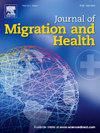Healthcare utilization patterns among migrant populations: Increased readmissions suggest poorer access. A population-wide retrospective cohort study
IF 2.9
Q1 PUBLIC, ENVIRONMENTAL & OCCUPATIONAL HEALTH
引用次数: 0
Abstract
Background:
Equal access to health ensures that all citizens, regardless of socio-economic status, can achieve optimal health, leading to a more productive, equitable, and resilient society. Yet, migrant populations were frequently observed to have lower access to health. The reasons for this are not entirely clear and may include language barriers, a lack of knowledge of the healthcare system, and selective migration (a “healthy migrant” effect).
Objective:
To examine differences in hospital utilization and readmission rates between Austrian and non-Austrian populations using nationwide hospital claims data, with the aim of disentangling the effects of potential barriers to healthcare access.
Methods:
Here, we use extensive medical claims data from Austria (13 million hospital stays of approximately 4 million individuals between 2015 and 2019) to compare the healthcare utilization patterns between Austrians and non-Austrians. We looked at the differences in primary diagnoses and hospital sections of initial hospital admission across different nationalities. We hypothesize that cohorts experiencing the “healthy migrant” effect show lower readmission rates after hospitalization compared to migrant populations that are in poorer health but show lower hospitalization rates due to barriers in access.
Results:
We indeed find that all nationalities showed lower hospitalization rates than Austrians, except for Germans, who exhibit a similar healthcare usage to Austrians. Although around 20% of the population has a migration background, non-Austrian citizens account for only 9.4% of the hospital patients and 9.79% of hospital nights. However, results for readmission rates are much more divergent. Nationalities like Hungary, Romania, and Turkey (females) show decreased readmission rates in line with the healthy migrant effect. Patients from Russia, Serbia, and Turkey (males) show increased readmissions, suggesting that their lower hospitalization rates are more likely due to access barriers.
Conclusion:
Considering the surge in international migration, our findings shed light on healthcare access, usage behaviours and gender differences across patients with different nationalities, offering new insights and perspectives.
移民人口的医疗保健利用模式:再入院人数增加表明获取机会较差。一项全人群回顾性队列研究
背景:平等获得卫生保健的机会确保所有公民,无论其社会经济地位如何,都能实现最佳健康,从而建立一个更有生产力、更公平和更有复原力的社会。然而,经常观察到移徙人口获得保健的机会较低。造成这种情况的原因尚不完全清楚,可能包括语言障碍、缺乏对医疗保健系统的了解以及选择性移民(“健康移民”效应)。目的:利用全国范围内的医院索赔数据,研究奥地利和非奥地利人口在医院使用率和再入院率方面的差异,目的是解开潜在障碍对医疗保健获取的影响。方法:在这里,我们使用来自奥地利的广泛医疗索赔数据(2015年至2019年期间约400万人的1300万次住院)来比较奥地利人和非奥地利人之间的医疗保健利用模式。我们观察了不同国籍患者初次入院的初步诊断和住院科室的差异。我们假设,与健康状况较差但由于准入障碍而住院率较低的移民人群相比,经历“健康移民”效应的队列在住院后的再入院率较低。结果:我们确实发现所有国家的住院率都低于奥地利人,除了德国人,他们表现出与奥地利人相似的医疗保健使用情况。虽然大约20%的人口有移民背景,但非奥地利公民只占住院病人的9.4%和住院夜的9.79%。然而,再入院率的结果却大相径庭。匈牙利、罗马尼亚和土耳其(女性)等国的再入境率下降,这与健康移民效应一致。来自俄罗斯、塞尔维亚和土耳其的患者(男性)显示再入院率增加,这表明他们较低的住院率更可能是由于准入障碍。结论:考虑到国际移民的激增,我们的研究结果揭示了不同国籍患者的医疗保健可及性、使用行为和性别差异,提供了新的见解和视角。
本文章由计算机程序翻译,如有差异,请以英文原文为准。
求助全文
约1分钟内获得全文
求助全文
来源期刊

Journal of Migration and Health
Social Sciences-Sociology and Political Science
CiteScore
5.70
自引率
8.70%
发文量
65
审稿时长
153 days
 求助内容:
求助内容: 应助结果提醒方式:
应助结果提醒方式:


